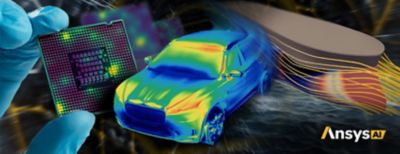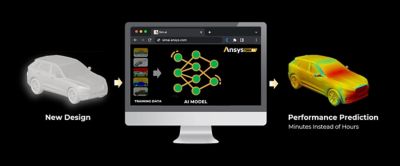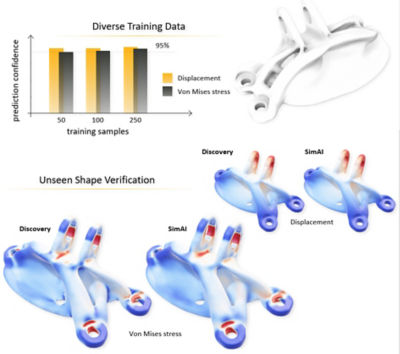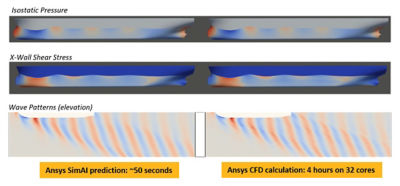-
United States -
United Kingdom -
India -
France -
Deutschland -
Italia -
日本 -
대한민국 -
中国 -
台灣
-
-
產品系列
查看所有產品Ansys致力於為當今的學生打下成功的基礎,通過向學生提供免費的模擬工程軟體。
-

無論您的職業或所在產業為何,都有現代的統一事實:人工智慧 (AI) 有潛力帶給您截然不同的工作流程,即便現在沒有,未來也將會如此。AI 特別適合工程師、設計師,以及其他將模擬功能整合至設計與開發來最佳化產品的人員,提供進一步強化這種最佳化的獨特機會。
Ansys SimAI 平台是 Ansys 的最新 AI 型技術,其結合 AI 與雲端運算的力量,讓您快速完成更高水準的創新。有了 SimAI 物理中性和雲端原生平台,您可以利用之前產生的 Ansys 或非 Ansys 資料來訓練 AI 模型,並在幾分鐘內評估電子、結構和流體等多種工程領域的新設計性能。
軟體即服務 (SaaS) 應用程式結合了 Ansys 模擬的預測準確度與透過雲端之生成式 AI 的速度。針對運算密集的專案,此組合能在其所有設計階段將模型效能提升 10-100 倍。讓我們來探索 SimAI 應用程式如何在四種不同的情境下,最佳化從晶片到船舶的設計。

Ansys SimAI 應用程式可在所有設計階段將模型效能的預測提升 10-100 倍,僅需幾分鐘就能提供模擬結果,無須花上數小時。
增強晶片設計
晶片設計需要複雜工程,這類工程經常涉及非線性、非預期的行為。模擬分析通常能針對電氣、熱和結構特性提供重要洞察,不僅能為設計提供資訊,還能改善效率、加速開發並確保驗證。但對於快速的設計迭代,即使是最健全的模擬工作流程也可能讓您覺得停滯不前,而且非常耗時。
最近想要加快探索晶片設計的團隊就遇到了這種情況。由於仰賴網域自訂化和晶片建模所需的大量元件,他們現有的方法會拖慢速度。而且只能提供有限的擴充能力。在流程中,模型的狀況稍有變更,就會大幅增加模擬時間。此外,很難有效呈現並對應空間分佈的不確定性及晶片參數的變化,包括晶粒大小和熱能傳輸係數 (HTC) 值。

SimAI 平台可最佳化晶片熱可靠度評估 (包括一致的溫度圖預測),使其在各設計變更比傳統模擬快上 20-80 倍。
透過整合 Ansys Mechanical 參數設計語言 (MAPDL) 與 SimAI 工具,團隊得以克服障礙、在設計過程中更早評估晶片熱可靠度,並加速工作流程。MAPDL 是一種指令碼語言,可與 Ansys Mechanical 有限元素分析 (FEA) 求解器互動,以自動化模擬工作並簡化工作流程。
基本上,SimAI 應用程式會採取三個簡單的步驟:上傳資料、訓練 AI 模型,以及預測。該團隊利用 Ansys Mechanical 的模擬結果建立了一套 AI 模型,此模型以 2,250 個不同的晶片熱模擬資料集為基礎。有了這項深入分析,應用程式就能在一分鐘內迅速預測溫度分佈圖。實況與預測之間的最大溫差會小於 0.5%。AI 預測能精準指出熱臨界位置。
用於晶片設計與熱可靠度評估之 SimAI 工具的主要優點包括:
- 快速評估晶片熱解決方案,速度比傳統模擬技術快上約 20 倍,並可加速分析各種系統情境。
- 加速並一致地預測各設計變更的溫度圖,速度可提升約 20-80 倍。
- 消除繁瑣的自適應磁碟區網格工作。
- 加快新一代晶片設計的開發生命週期。
增強引擎托架
在航太應用中,結構分析與空氣動力評估同樣重要,即使是最微不足道的零件也一樣。考慮噴射引擎支架,也稱為負載支架。與引擎本身相比,它們看似微小但卻是不可或缺的元件,因為這些支架支援著引擎的重量。
因此,開發符合重量及穩健性結構要求和限制的全新噴射引擎支架設計,是一個艱鉅的流程。參考現有的設計,並運用先前專案的知識頗有成效。SimAI 應用程式也可協助此工作流程。
利用多工具工作流程,包括 Ansys Discovery 3D 設計建模與 Ansys optiSLang 程序整合與設計最佳化軟體的功能,其中一個團隊使用約 250 個訓練樣本來建立 AI 模型,其中包括不同和拓撲多元的托架設計。利用過去模擬所提供的深入見解,應用程式可在幾秒鐘內預測新形狀的行為。針對未來的專案,則可以使用不同設計重新訓練相同的 AI 模型,以擷取新的深入見解。
Discovery 3D 建模軟體無需經過訓練便可在首次嘗試時,準確快速地模擬任何設計。SimAI 應用程式可在已模擬的設計空間內提供極為快速的預測,以協助對已應用的情境進行最佳化、大小調整和選擇。工程師可利用 Discovery 和 SimAI 平台來產生準確的資料、豐富訓練流程並徹底深入瞭解未來的產品行為。
用於噴射引擎托架設計之 SimAI 應用程式的主要優點包括:
- 零廢料,可減少材料使用量。過去的設計很有價值,因為即使是失敗的設計也能是知識的來源。
- 最高可減少 90% 的工作流程,能夠在電腦輔助設計 (CAD) 和多重物理量模擬之間輕鬆切換。
- 包括非專業人員在內,團隊全員皆可存取。在 AI 指導的支援下,團隊成員不再需要深厚的物理知識。

AI 模型能為每份預測提供信賴水準。如圖表所示,信賴水準會隨著訓練樣本數量而增加。
提高汽車空氣動力
隨著世界各地對環境的專注與日俱增,汽車製造商必須符合與日俱增的要求,以降低二氧化碳 (CO2) 排放量。許多減量計畫和規範,例如全球調和輕型車輛測試程序 (WLTP),都會要求汽車製造商評估新車款中所有設計變數的空氣動力性能。
可惜的是,風洞測試是成本高昂且緩慢的解決方案,但加快開發時間以推行新一代電動車至關重要。更快的空氣動力性能模擬預測對於滿足需求、保持競爭力和降低成本非常關鍵。
將 SimAI 平台與 Ansys Fluent 計算流體動力學 (CFD) 軟體搭配使用,以評估運動型多用途車 (SUV) 的空氣動力效能。團隊利用約 50 個 CFD 結果來建立 AI 模型,其中包括汽車外型變化和拓撲變化,例如後視鏡、滑雪車架和擾流器。在 AI 型的應用程式的支援下,不到一分鐘就能完成新 SUV 的幾何預測。此外,應用程式的阻力錯誤結果與 CFD 結果的差距小於 0.5%。更會針對流動特性產生準確預測,包括表面摩擦和尾流拓撲。

SimAI 功能最高可將汽車空氣動力的設計速度提高 10-100 倍。
SimAI 汽車空氣動力評估平台的主要優點包括:
- 增加設計替代方案評估 — 比傳統模擬方法高出 20 倍,並能快速最佳化設計。
- 利用先前設計階段或前代車輛所使用的 CFD 模擬,即使幾何結構不一致也能加速並一致地預測各設計變更的空氣動力性能,且速度可提升 10-100 倍。
- 在過程中更早整合模擬功能,也就是「將模擬左移」可加速設計過程並降低成本。如此一來,設計師便能在所有設計階段整合快速且有意義的空氣動力預測。
提供資訊並加速船體設計
與汽車產業類似,運輸公司被鼓勵減少排放量。其中一個例子就是國際海事組織 (IMO) 的大力推動,以降低國際運輸的排放量。為了實現這點,其中一種方法是通過優化船體形狀來提高船舶阻力,這直接轉化爲能源效率和燃料節省。然而,若要同時使用許多不同變數來評估多種船體設計,就需要快速又有效率的模擬。
利用 SimAI 工具,工程師得以使用 288 個 CFD 結果來建立 AI 模型,其中包括船體形狀變化,以及吃水和船速等操作條件。不到一分鐘,此工具即可預測全新的最佳化船體幾何。此外,相較於 CFD 模擬結果,此工具的阻力錯誤結果低於 5%,且波模式預測完全準確。
SimAI 工具用於船體設計的主要優點包括:
- 在幾分鐘內而不是幾天內加速評估新船體設計的性能。
- 在早期設計階段做出明智的決策。
- 能省下時間去進行具有附加價值的工作,如設計探索,帶來更多創新時間。
若要進一步瞭解,請下載白皮書 :「如何運用 Ansys SimAI 改善船體設計。」

將計算流體動力學 (CFD) 等傳統模擬方法與 SimAI 工具結合,讓您不到一分鐘就能預測船體設計的新幾何。
採用 AI 支援的模擬
AI 與機器學習 (ML) 方法可應用在半導體、航太、汽車與海運等多種產業的設計與開發。藉由整合 AI/ML 與模擬和電腦輔助工程 (CAE),不同領域的團隊可以更快速準確地解決多重物理量和工程挑戰,從而強化設計探索與最佳化。如先前的情境所示,這類 AI/ML 支援的最佳化可提高效率、節省成本,最終帶來更好的產品。
SimAI 應用程式讓工程師和設計師都能運用先前的模擬和測量資料來訓練和建立替代 AI 模型。藉由使用此 AI 模型,他們可以利用花費數分鐘而非數小時或數天得出的評估,來加速設計過程。
若要進一步瞭解平台如何最佳化您從晶片到船舶的設計,請報名參加即將舉辦的線上研討會系列「利用 AI 加速模擬」。














